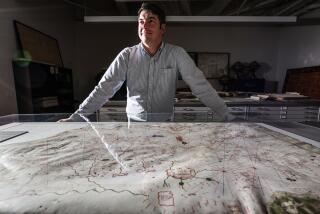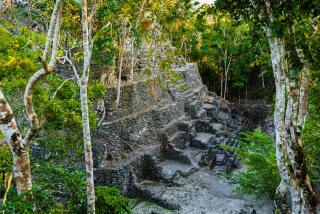Oldest known Maya calendar found in Guatemala
In the remote northeastern corner of Guatemala, archaeologists have found what appears to be the 9th century workplace of a city scribe, an unusual dwelling adorned with magnificent pictures of the king and other royals and the oldest known Maya calendar.
This year has been particularly controversial among some cultists because of the belief that the Maya calendar predicts a major cataclysm — perhaps the end of the world — on Dec. 21, 2012. Archaeologists know that is not true, but the new find, written on the plaster equivalent of a modern scientist’s whiteboard, strongly reinforces the idea that the Maya calendar projects thousands of years into the future.
The astronomical calculations are similar to those found in the well-known Dresden Codex, a bark-paper Maya book from the 11th or 12th century, and they may yield insights on how that well-known work was prepared.
But scientists say the real value of the find is the rare appearance of paintings and numerical calculations. The building, dating from about AD 813 in what is known as the Classic Maya period, contains the oldest known Maya astronomical tables and the only preserved artwork not found in a palace.
The discoveries, made in a region of lowland rain forest, are unusual because artwork and writings from the area are easily destroyed by heat and rain.
“The state of preservation was remarkable,” said archaeologist William A. Saturno of Boston University, who led the expedition.
“We’ve never seen anything like it,” added archaeologist David Stuart of the University of Texas at Austin, who is deciphering the hieroglyphs.
The artwork and writings are reported in Friday’s edition of the journal Science and in the May 29 issue of National Geographic magazine.
The discovery was made at a site called Xultun, which was discovered in 1915 but not thoroughly studied until recently because of its isolation. One of Saturno’s students, Maxwell Chamberlain, was on a lunch break in 2010 when he spied what appeared to be very faint paint on a stone in a looter’s trench.
When Saturno dug farther into the room opened by the trench, he said he was shocked to find a mural of a king sitting on a throne holding a white scepter and wearing a red-feathered crown with a headdress streaming away from him. A courtier or servant peeks out from behind him.
The archaeologists immediately preserved the site and came back the next year to excavate it. The 40-square-foot room had been filled with rubble before other structures were built on top of it. That was an unusual practice for the Maya, who typically collapsed roofs and walls before rebuilding, and had done so to other rooms around the site. But it led to the preservation.
The portrait of the king was found in a rounded niche on the north wall of the structure. Bone curtain rods would have allowed a drape to be drawn across it to hide it.
On the wall next to it is the portrait of a figure in brilliant orange, with jade bracelets, holding a stylus. The figure, who may have been a scribe, was labeled “younger brother obsidian” or perhaps “junior obsidian.” He may have been the king’s son or brother, the team said.
A mural on the west wall shows three identically dressed individuals, painted in black. Each wears a simple loincloth, a white medallion and a large black headdress with a single red feather. No such grouping of identical headdresses had been seen before. The largest figure in the group is labeled “older brother obsidian,” or perhaps “senior obsidian.”
On the east wall are rough sketches of people and several different areas with columns of numbers and calculations, either written with red and black paint or inscribed in plaster. Several areas appear to have been plastered over several times, as if to provide fresh writing surfaces.
Not all of the writing has been deciphered yet, but some clearly describe the 260-day ceremonial calendar, the 365-day solar calendar, the 584-day cycle of Venus and the 780-day cycle of Mars. Another calendar nearby comprises 17 baktuns, or 400-year periods, encompassing an additional 4,000 years beyond the 21st century.
“This is our first real look at this kind of writing and this kind of a space in a Maya city,” Saturno said.
Stuart acknowledged that “we don’t know exactly what this is noting,” but the Maya were looking at “patterns in the sky and intermeshing them mathematically.”
Among other things, the calculations showed which god was the patron of each day and month, marked celestial events tied to religious ceremonies and allowed astronomers to calculate the dates of eclipses, which were important in rituals.
More to Read
Sign up for Essential California
The most important California stories and recommendations in your inbox every morning.
You may occasionally receive promotional content from the Los Angeles Times.








